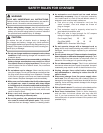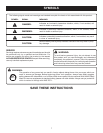
4
SPECIFIC SAFETY RULES
PRECAUTIONS AGAINST KICKBACK
Kickback is a dangerous reaction that can lead to serious
injury.
Keep a firm grip on the unit with both hands when
operating the unit. Place your right hand on the rear
handle and your left hand on the front handle. A firm grip
will help you reduce kickback and maintain control of the
unit.
Make sure that the area in which you are cutting is
free from obstructions. Do not let the blade come in
contact with any obstruction while operating the unit.
Always cut with the unit at full speed. Fully squeeze
the trigger and maintain a steady cutting speed.
Use only the replacement blade specified for your
unit.
ELECTRICAL SAFETY
A battery operated tool with integral batteries or a
separate battery pack must be recharged only with
the specified charger for the battery. A charger that
may be suitable for one type of battery may create a risk
of fire when used with another battery.
Use battery operated tool only with specifically
designated battery pack. Use of any other batteries
may create a risk of fire.
Use battery only with charger listed.
MODEL BATTERY PACK (P100) CHARGER (P110)
P2500 130255004 1423701, 140237023
or 130224028 or 140237021
Battery tools do not have to be plugged into an elec-
trical outlet; therefore, they are always in operating
condition. Be aware of possible hazards when not
using your battery tool or when changing accessories.
Following this rule will reduce the risk of electric shock,
fire, or serious personal injury.
Disconnect battery pack from tool or place the switch
in the locked or off position before making any adjust
-
ments, changing accessories, or storing the tool. Such
preventive safety measures reduce the risk of starting the
tool accidentally.
Do not place battery tools or their batteries near fire
or heat. This will reduce the risk of explosion and pos-
sibly injury.
Do not mutilate the battery pack. Released electrolyte
is corrosive and may cause damage to the eyes or skin.
It may be toxic if swallowed.
Never use a battery that has been dropped or
received a sharp blow. A damaged battery is subject
to explosion. Properly dispose of a dropped or damaged
battery immediately.
Batteries vent hydrogen gas and can explode in the
presence of a source of ignition, such as a pilot light.
To reduce the risk of serious personal injury, never use
any cordless product in the presence of open flame. An
exploded battery can propel debris and chemicals. If
exposed, flush with water immediately.
Do not charge battery tool in a damp or wet
location. Following this rule will reduce the risk of electric
shock.
For best results, your battery tool should be charged
in a location where the temperature is more than
50°F but less than 100°F. Do not store outside or in
vehicles.
Under extreme usage or temperature conditions, bat-
tery leakage may occur. If liquid comes in contact with
your skin, wash immediately with soap and water, then
neutralize with lemon juice or vinegar. If liquid gets
into your eyes, flush them with clean water for at least
10 minutes, then seek immediate medical attention.
When battery pack is not in use, keep it away from
other metal objects like: paper clips, coins, keys, nails,
screws, or other small metal objects that can make
a connection from one terminal to another. Shorting
the battery terminals together may cause sparks, burns,
or a fire.


















